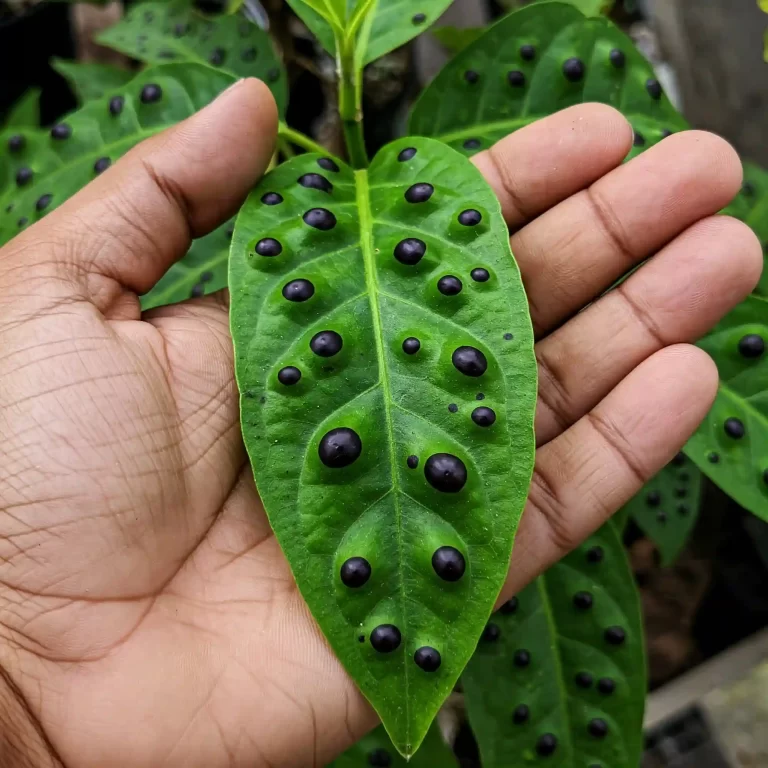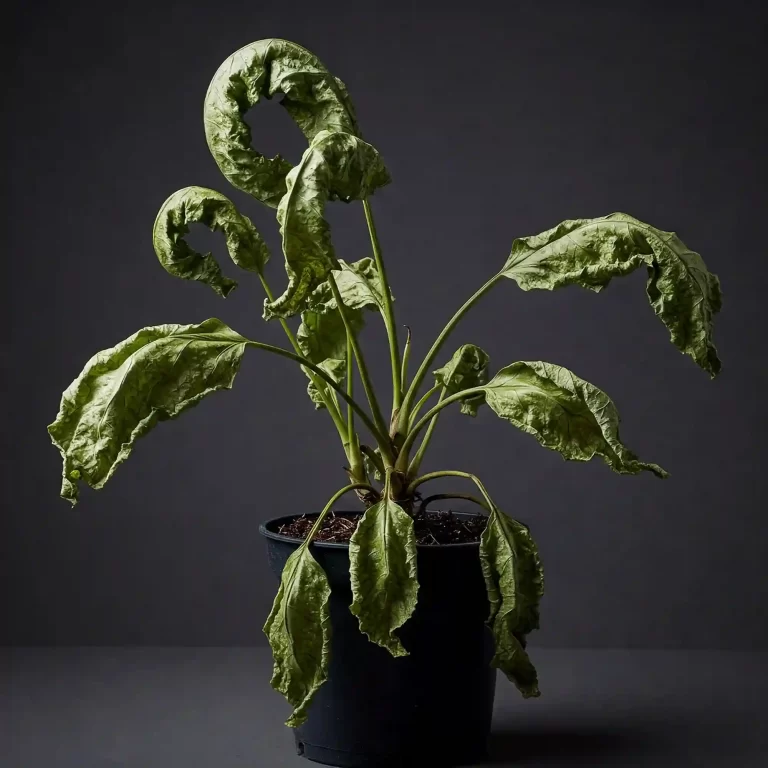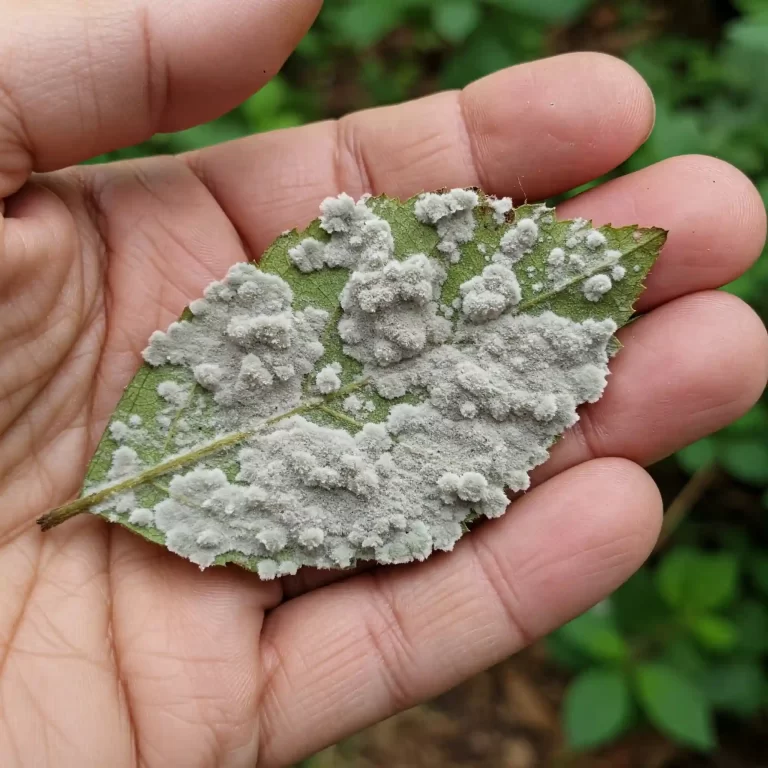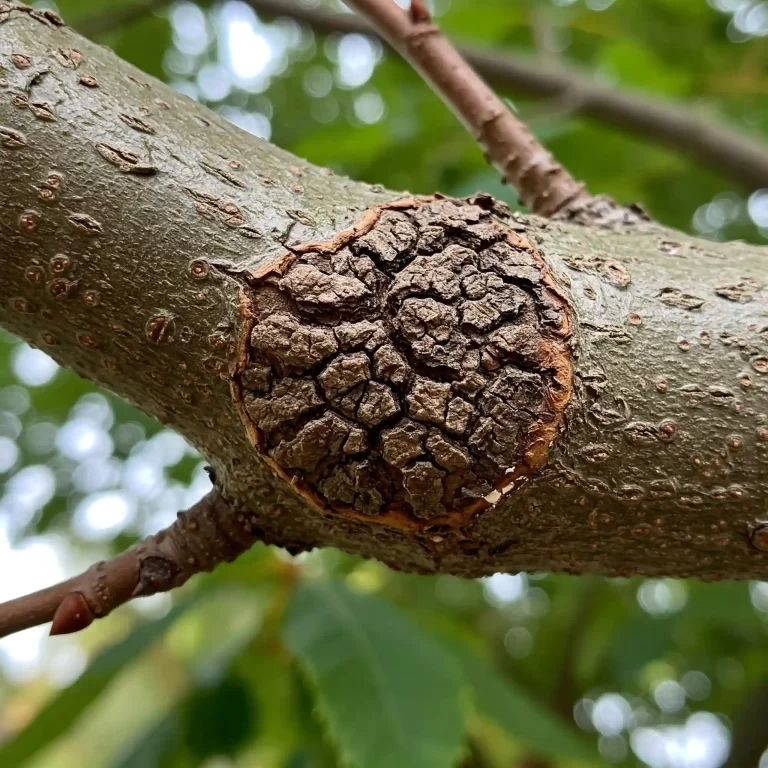| Key Takeaways |
|---|
| – Lemon lime maranta is a tropical plant with striking foliage and fascinating behavior. |
| – It needs bright indirect light, warm and humid conditions, and moist but well-draining soil. |
| – It should be watered once a week on average, fertilized every two weeks in spring and summer, and repotted every one or two years. |
| – It can be pruned to remove dead or damaged leaves, and propagated by root division or stem cuttings. |
| – It is prone to some common problems, such as fungal infections, root rot, and pests, which can be prevented or treated with proper care. |
If you are looking for a plant that can brighten up your home with its stunning foliage and fascinating behavior, look no further than the lemon lime maranta. This plant, also known as the prayer plant, has beautiful green leaves with yellow stripes that fold up at night like praying hands. It is a low-maintenance plant that can add a touch of tropical flair to any space.
In this article, you will learn everything you need to know about how to care for your lemon lime maranta, from watering and lighting to fertilizing and propagating. You will also discover some common problems and solutions, as well as some fun facts and tips to make your plant happy and healthy.
Let’s get started by looking at the optimal conditions for your lemon lime maranta, followed by a step-by-step guide on how to care for it. Then, we will explore some ways to propagate your plant and expand your collection. Finally, we will address some frequently asked questions and troubleshoot some issues that you might encounter with your plant.
Optimal Conditions for Your Lemon Lime Maranta
Your lemon lime maranta is a tropical plant that thrives in warm, humid, and bright conditions. By recreating these conditions in your home, you will help your plant grow and flourish.
Temperature
Your lemon lime maranta prefers a moderate temperature range of 60 to 80 degrees Fahrenheit (15.5 to 26.7 degrees Celsius). It does not like cold drafts or hot air vents, which can stress it out. You can use a thermometer to monitor the temperature in your plant’s location, and move it away from any sources of cold or heat.
If the temperature drops below 50 degrees Fahrenheit (10 degrees Celsius), your plant may suffer from cold damage, which can cause the leaves to turn black or brown. If the temperature rises above 85 degrees Fahrenheit (29.4 degrees Celsius), your plant may suffer from heat stress, which can cause the leaves to wilt or curl. To prevent these problems, you can cover your plant with a cloth or move it to a more suitable spot during extreme weather.
Light
Your lemon lime maranta needs bright indirect light to maintain its vibrant color and variegation. It does not tolerate direct sun, which can scorch its leaves. It also does not do well in low light, which can make it lose its color and vitality. A good spot for your lemon lime maranta is near an east or west window, or a shaded south window. You can also use a grow light or a fluorescent lamp to supplement the natural light.
If your plant gets too much sun, you may notice the leaves becoming pale, bleached, or burned. If your plant gets too little light, you may notice the leaves becoming dark, dull, or leggy. To prevent these problems, you can adjust the position of your plant or use a sheer curtain to filter the light.
Humidity
Your lemon lime maranta loves high humidity, as it is native to the humid rainforest. You can use a hygrometer to measure the humidity in your plant’s location, and aim for at least 50%. You can increase the humidity by using a humidifier, a pebble tray, or a group of other plants. You can also mist your lemon lime maranta occasionally to keep it cool and comfortable. However, avoid misting the leaves directly, as this can cause fungal infections. Instead, mist the air around the plant or the soil surface.
If your plant gets too dry, you may notice the leaves becoming crispy, brown, or curled. If your plant gets too wet, you may notice the leaves becoming soggy, yellow, or spotted. To prevent these problems, you can monitor the humidity level and adjust it accordingly.
How to Care for Your Lemon Lime Maranta
Caring for your lemon lime maranta is not difficult, but it does require some attention and regularity. Here are the main things you need to do to keep your plant healthy and happy.
Watering
Watering your lemon lime maranta is one of the most important and tricky aspects of its care. You need to water your plant regularly, but avoid overwatering or underwatering. The soil should be moist but not soggy or dry. You can check the soil with your finger before watering. If it feels dry an inch below the surface, it is time to water. If it feels wet, wait until it dries slightly. You can also look at the leaves for signs of thirst or drowning. If they curl up, they need more water. If they turn yellow or brown, they have too much water.
You should water your plant once a week on average, but adjust the frequency according to the season, temperature, and humidity. Use room-temperature water and water thoroughly until the excess drains out of the bottom of the pot. Make sure the pot has drainage holes and a saucer to catch the runoff. Do not let the plant sit in water, as this can cause root rot.
Fertilizing
Fertilizing your lemon lime maranta is another important aspect of its care, as it provides the nutrients it needs to grow and flourish. You should fertilize your plant every two weeks during the growing season, which is spring and summer. Use a balanced liquid fertilizer diluted to half strength, or a slow-release granular fertilizer. Do not fertilize your plant in the winter, when it is dormant. Too much fertilizer can burn the roots and damage the leaves.
You can tell if your plant is overfertilized if it has brown tips, yellow edges, or wilted leaves. If this happens, flush the soil with water and reduce the amount and frequency of fertilizing. You can tell if your plant is underfertilized if it has pale, leggy, or slow growth. If this happens, increase the amount and frequency of fertilizing, but do not exceed the recommended dosage.
Repotting
Repotting your lemon lime maranta is necessary when it becomes root-bound, which is usually every one or two years. You can tell if your plant is root-bound if it has roots growing out of the drainage holes, or if the soil dries out quickly. Repotting your plant will give it more space and fresh soil to grow and thrive.
To repot your plant, choose a pot that is one size larger than the current one, and has drainage holes. Gently remove the plant from the old pot and shake off the excess soil. Trim any damaged or diseased roots. Place the plant in the new pot and fill it with fresh potting mix. Water thoroughly and place it in a bright spot. Avoid fertilizing your plant for a few weeks after repotting, as it needs time to adjust and recover.
Pruning
Pruning your lemon lime maranta is optional, but it can help improve its appearance and health. You can prune your plant to remove any dead, damaged, or diseased leaves. You can also trim the stems to shape the plant or encourage bushier growth. Use clean and sharp scissors or pruning shears to make clean cuts. Dispose of the cuttings properly and avoid leaving them on the soil, as they can attract pests or diseases.
How to Propagate Your Lemon Lime Maranta
Propagating your lemon lime maranta is a great way to expand your collection and share your plant with others. It is also a fun and rewarding activity that you can enjoy with your plant. There are two main methods of propagating your lemon lime maranta: root division and stem cuttings. Both methods are simple and effective, and you can do them anytime of the year.
Root Division
Root division is the easiest method of propagating your lemon lime maranta, and you can do it when you repot your plant. Simply divide the root ball into two or more sections, making sure each section has some roots and leaves. Plant each section in a separate pot and water well. Place them in a bright and humid spot and watch them grow.
Stem Cuttings
Stem cuttings are another method of propagating your lemon lime maranta, and you can do it anytime. Cut a stem that has at least two or three nodes, which are the bumps where the leaves grow. Remove the lower leaves and dip the cut end in rooting hormone. Plant the cutting in moist potting mix or water. Keep it in a warm and humid place until it develops roots. Then, transplant it to a larger pot and treat it like a mature plant.
Frequently Asked Questions and Troubleshooting
Here are some of the most common questions and problems that you might have with your lemon lime maranta, and how to solve them.
Why is my lemon lime maranta not folding its leaves at night?
One of the most interesting features of your lemon lime maranta is that it folds its leaves at night like praying hands. This is a natural phenomenon called nyctinasty, which is a response to changes in light and temperature. Your lemon lime maranta does this to conserve water and protect itself from predators and cold.
However, sometimes your lemon lime maranta may not fold its leaves at night, or may fold them partially or irregularly. This can be due to several reasons, such as:
- Insufficient light: If your plant does not get enough light during the day, it may not be able to sense the difference between day and night, and may not fold its leaves accordingly. To fix this, you can move your plant to a brighter spot or use a grow light to provide supplemental light.
- Inconsistent light: If your plant is exposed to artificial light at night, such as from a lamp, a TV, or a streetlight, it may confuse its circadian rhythm and prevent it from folding its leaves. To fix this, you can turn off or dim the lights near your plant at night, or use a curtain to block the light.
- Stress: If your plant is stressed by factors such as overwatering, underwatering, overfertilizing, underfertilizing, pests, diseases, or temperature fluctuations, it may not fold its leaves as a sign of distress. To fix this, you can identify and eliminate the source of stress and provide proper care for your plant.
- Age: If your plant is old or mature, it may not fold its leaves as much as when it was young or juvenile. This is normal and does not indicate any problem with your plant. You can enjoy its beauty and grace regardless of its age.
Why is my lemon lime maranta flowering?
Another interesting feature of your lemon lime maranta is that it can produce small white flowers in the spring or summer. This is a rare and special occasion, as it indicates that your plant is happy and healthy. However, not all lemon lime marantas will flower, and it depends on several factors, such as:
- Light: Your plant needs bright indirect light to produce flowers, as it stimulates the production of hormones that trigger flowering. If your plant gets too little or too much light, it may not flower. You can provide optimal light for your plant by placing it near an east or west window, or a shaded south window. You can also use a grow light or a fluorescent lamp to supplement the natural light.
- Water: Your plant needs consistent moisture to produce flowers, as it prevents the plant from wilting or drying out. You should water your plant once a week on average, but adjust the frequency according to the season, temperature, and humidity. You should also mist your plant occasionally to keep it hydrated and cool. However, avoid overwatering or underwatering your plant, as this can cause root rot or leaf curling, which can inhibit flowering.
- Fertilizer: Your plant needs balanced nutrients to produce flowers, as it supports the growth and development of the plant. You should fertilize your plant every two weeks during the growing season, which is spring and summer. Use a balanced liquid fertilizer diluted to half strength, or a slow-release granular fertilizer. However, avoid overfertilizing or underfertilizing your plant, as this can burn the roots or stunt the growth, which can inhibit flowering.
- Temperature: Your plant needs moderate temperatures to produce flowers, as it mimics its natural habitat. You should maintain a temperature range of 60 to 80 degrees Fahrenheit (15.5 to 26.7 degrees Celsius) for your plant. You should also avoid temperature extremes and fluctuations, such as cold drafts or hot air vents, which can stress your plant and prevent it from flowering.
If your lemon lime maranta is flowering, you can enjoy its delicate and fragrant blooms for a few weeks. You can also cut the flowers and use them as a cut flower arrangement, as they can last for a long time in water. However, you should also be aware that flowering can take a lot of energy from your plant, and it may affect its foliage and overall health. You can help your plant recover by providing extra care and attention, such as watering, fertilizing, and pruning. You can also remove the flowers once they fade, to prevent the plant from producing seeds, which can further drain its energy.
How to Prevent and Treat Common Problems with Your Lemon Lime Maranta
Your lemon lime maranta is a resilient and hardy plant, but it can still suffer from some common problems, such as fungal infections, root rot, and pests. These problems can affect the health and appearance of your plant, and even kill it if left untreated. However, you can prevent and treat these problems with proper care and attention.
Fungal Infections
Fungal infections are caused by fungi that thrive in moist and humid conditions. They can infect your plant through the soil, the water, or the air. They can cause various symptoms, such as leaf spots, powdery mildew, stem rot, or crown rot. They can also spread to other plants and contaminate your environment.
To prevent fungal infections, you should:
- Use a well-draining potting mix that contains peat moss or coconut coir and perlite. This will help prevent waterlogging and improve aeration.
- Water your plant only when the soil is dry an inch below the surface. This will help avoid overwatering and soggy soil.
- Mist your plant occasionally, but avoid misting the leaves directly. This will help increase the humidity without creating wet conditions for fungi.
- Provide good air circulation around your plant. This will help reduce the humidity and prevent fungal spores from settling on your plant.
- Sterilize your tools and pots before using them. This will help prevent the introduction of fungi from other sources.
To treat fungal infections, you should:
- Isolate your infected plant from other plants. This will help prevent the spread of fungi to other plants.
- Remove any infected leaves or stems with clean and sharp scissors or pruning shears. This will help stop the infection from spreading to other parts of the plant.
- Apply a fungicide to your plant according to the instructions on the label. This will help kill the fungi and protect your plant from further infection. You can use a commercial fungicide or a homemade one, such as baking soda, vinegar, or hydrogen peroxide.
- Repot your plant in fresh potting mix and a clean pot. This will help eliminate any fungi in the soil and the pot.
Root Rot
Root rot is caused by overwatering or poor drainage, which can lead to the decay of the roots. It can also be caused by fungal or bacterial infections that attack the roots. It can cause various symptoms, such as yellowing, wilting, or dropping of leaves, soft or mushy stems, or a foul smell from the soil. It can also cause the death of your plant if left untreated.
To prevent root rot, you should:
- Use a well-draining potting mix that contains peat moss or coconut coir and perlite. This will help prevent waterlogging and improve aeration.
- Water your plant only when the soil is dry an inch below the surface. This will help avoid overwatering and soggy soil.
- Make sure your pot has drainage holes and a saucer to catch the runoff. This will help prevent the accumulation of water in the bottom of the pot.
- Empty the saucer after watering. This will help prevent the plant from sitting in water, which can cause root rot.
To treat root rot, you should:
- Remove your plant from the pot and inspect the roots. This will help you assess the extent of the damage and the cause of the problem.
- Cut off any rotten or diseased roots with clean and sharp scissors or pruning shears. This will help stop the decay from spreading to other roots.
- Wash the remaining roots with water to remove any dirt or fungi. This will help clean and disinfect the roots.
- Apply a root stimulator or a fungicide to the roots according to the instructions on the label. This will help promote the growth and health of the roots and protect them from further infection.
- Repot your plant in fresh potting mix and a clean pot. This will help eliminate any pathogens in the soil and the pot.
Pests
Pests are insects or animals that feed on your plant and cause damage to its leaves, stems, or roots. They can also transmit diseases or viruses to your plant. Some of the common pests that can affect your lemon lime maranta are spider mites, mealybugs, aphids, scale insects, and thrips. They can cause various symptoms, such as webbing, cottony masses, sticky honeydew, black sooty mold, or distorted or discolored leaves. They can also reduce the growth and vigor of your plant.
To prevent pests, you should:
- Inspect your plant regularly for any signs of pests or damage. This will help you detect and treat any infestation early and prevent it from worsening.
- Provide good air circulation around your plant. This will help deter pests from settling on your plant and make it harder for them to reproduce.
- Wash your plant occasionally with water or a mild soap solution. This will help remove any dust or dirt that can attract pests and also dislodge any pests that are already on your plant.
- Quarantine any new plants before introducing them to your existing ones. This will help prevent the introduction of pests from other sources.
To treat pests, you should:
- Isolate your infested plant from other plants. This will help prevent the spread of pests to other plants.
- Remove any visible pests or eggs with a cotton swab, a tweezers, or a soft brush. This will help reduce the population and damage of the pests.
- Spray your plant with an insecticide or a homemade one, such as neem oil, rubbing alcohol, or dish soap. This will help kill the pests and protect your plant from further infestation. You should follow the instructions on the label or the recipe and repeat the treatment as needed until the pests are gone.
Fun Facts and Tips for Your Lemon Lime Maranta
Your lemon lime maranta is not only a beautiful and easy-to-care-for plant, but also a fascinating and rewarding one. Here are some fun facts and tips that you might not know about your plant, and that can help you enjoy it even more.
- Your lemon lime maranta is a pet-safe and non-toxic plant, which means that it is safe for your furry friends to nibble on. However, you should still keep your plant out of reach of your pets, as they can damage or knock over your plant, or cause digestive issues if they eat too much of it.
- Your lemon lime maranta is a rhizomatous plant, which means that it grows from a horizontal stem that produces roots and shoots. This makes your plant easy to propagate by root division, as you can simply cut off a piece of the rhizome and plant it in a new pot. You can also use this feature to create a fuller and bushier plant, by cutting off the tips of the stems and replanting them in the same pot as the mother plant.
- Your lemon lime maranta is a perennial plant, which means that it can live for more than two years. However, it is not frost-hardy, and can only survive outdoors in USDA hardiness zones 11 and 12, where the minimum temperature is above 40 degrees Fahrenheit (4.4 degrees Celsius). If you live in a colder climate, you can grow your plant indoors as a houseplant, or outdoors as an annual or a container plant that you can bring inside during the winter.
- Your lemon lime maranta is a versatile plant, which means that it can adapt to different situations and environments. You can grow your plant as a hanging basket, a table-top plant, a ground cover, or a terrarium plant. You can also mix your plant with other plants that have similar requirements, such as calathea, stromanthe, or ferns. You can create a stunning and colorful display that will impress your guests and brighten up your home.
We hope that this article has helped you learn more about your lemon lime maranta, and how to care for it properly. Your lemon lime maranta is a wonderful plant that can bring you joy and satisfaction for many years. If you have any questions or comments, feel free to leave them below. We would love to hear from you and see your lemon lime maranta photos. Happy gardening!




